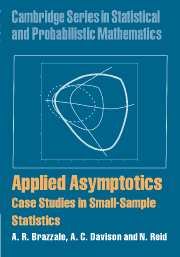Book contents
- Frontmatter
- Contents
- Preface
- 1 Introduction
- 2 Uncertainty and approximation
- 3 Simple illustrations
- 4 Discrete data
- 5 Regression with continuous responses
- 6 Some case studies
- 7 Further topics
- 8 Likelihood approximations
- 9 Numerical implementation
- 10 Problems and further results
- A Some numerical techniques
- References
- Example index
- Name index
- Index
Preface
Published online by Cambridge University Press: 19 November 2009
- Frontmatter
- Contents
- Preface
- 1 Introduction
- 2 Uncertainty and approximation
- 3 Simple illustrations
- 4 Discrete data
- 5 Regression with continuous responses
- 6 Some case studies
- 7 Further topics
- 8 Likelihood approximations
- 9 Numerical implementation
- 10 Problems and further results
- A Some numerical techniques
- References
- Example index
- Name index
- Index
Summary
The likelihood function plays a central role in both statistical theory and practice. Basic results about likelihood inference, which we call first order asymptotics, were developed in fundamental work by R. A. Fisher during the 1920s, and now form an essential and widely taught part of both elementary and advanced courses in statistics. It is less well known that Fisher later proposed a more refined approach, which has been developed over the past three decades into a theory of higher order asymptotics. While this theory leads to some extremely accurate methods for parametric inference, accounts of the theory can appear forbidding, and the results may be thought to have little importance for statistical practice.
The purpose of this book is dispel this view, showing how higher order asymptotics may be applied in realistic examples with very little more effort than is needed for first order procedures, and to compare the resulting improved inferences with those from other approaches. To do this we have collected a range of examples and case studies, provided details on the implementation of higher order approximations, and compared the resulting inference to that based on other methods; usually first order likelihood theory, but where appropriate also methods based on simulation. Our examples are nearly all derived from regression models for discrete or continuous data, but range quite widely over the types of models and inference problems where likelihood methods are applied.
- Type
- Chapter
- Information
- Applied AsymptoticsCase Studies in Small-Sample Statistics, pp. vii - viiiPublisher: Cambridge University PressPrint publication year: 2007

